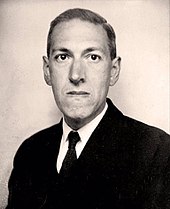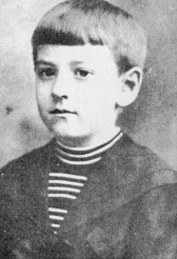H. P. Lovecraft
![]()
This article is about the writer. For other meanings of H. P. Lovecraft or Howard Phillips Lovecraft, see H. P. Lovecraft (disambiguation).
Howard Phillips Lovecraft (* August 20, 1890 in Providence, Rhode Island; † March 15, 1937 ibid; usually just H. P. Lovecraft) was an American writer. He is considered the most important author of fantastic horror literature of the 20th century and influenced numerous successors with the Cthulhu myth he invented.
During Lovecraft's lifetime, only the extensive tale Shadows over Innsmouth was published as a book, while the other texts were published in pulp magazines such as Weird Tales. After his death, August Derleth and Donald Wandrei edited several anthologies published by Arkham House, which were reprinted in many paperbacks.
In this way, Lovecraft developed into a cult figure in the following years, who was often uncritically and epigonally revered and imitated. Numerous imitations and film adaptations from the fund of the Cthulhu mythos were generally not up to par. Along with the reverence, there was also brusque rejection, gloating, and ridicule from some quarters. In the course of time, literary critics and essayists dealt with Lovecraft, examining style and narrative technique, psychology, mythology, and also racist ideas that show up in some stories, treatises, and letters.

H. P. Lovecraft, photograph from 1934
Live
Howard Phillips Lovecraft was born in Providence, Rhode Island in 1890. His father, Winfield Scott Lovecraft, was a traveling salesman. His mother, Sarah Susan Phillips Lovecraft, was able to trace her family tree back to 1630, when her ancestors had reached Massachusetts Bay to settle. Lovecraft was the first child of his parents, who were both over 30 years old when he came into the world. The house where he was born, at 194 Angell Street (now 454), was demolished in 1961.
When Lovecraft was three years old, his father suffered an (alleged) nervous breakdown in a Chicago hotel and was taken to Butler Hospital in Providence, where he remained until his death five years later. The cause of death was given as "general paresis." This term was also used at the time to describe the symptoms of advanced syphilis disease, known as neurolues. It was therefore assumed that Lovecraft's father had suffered from syphilis.
From then on, Lovecraft was raised mainly by his mother, grandfather, and two aunts, and showed literary talent at an early age. He memorized poems as a toddler and began writing his own at the age of six. His grandfather encouraged this inclination, as well as Lovecraft's interest in the mysterious and fantastic, by giving him books to read such as the Tales of the Thousand and One Nights and children's editions of classics such as the Odyssey and the Iliad. The grandfather also told Lovecraft self-invented horror stories, partly to the displeasure of his mother, who worried about their possible influence on the boy.
Lovecraft had both physical and psychological problems during his school years, so he attended classes sporadically until the age of eight, and then was withdrawn from school a year later due to his aggressive and undisciplined behavior. During this time Lovecraft read widely and developed a great enthusiasm for New England history, chemistry, and astronomy, and from 1899 wrote handwritten journals on these subjects, such as The Scientific Gazette and The Rhode Island Journal of Astronomy, which he distributed among his relatives and friends. Four years later, at the age of 13, Lovecraft re-enrolled in school, at Hope Street High School in Providence.
Youth
Lovecraft's grandfather died in 1904 and the family soon fell into poverty as the estate was soon depleted as a result of mismanagement. The family had to give up their home and move into a boarding house in the same street. Lovecraft suffered so badly from the changes, especially from losing his birthplace, that for a time he entertained suicidal intentions. In 1908, near the end of his senior year, Lovecraft suffered a nervous breakdown, so he never earned a high school diploma. The fact that he was never able to finish his school career or attend Brown University as he had wished, he found painful and shameful even late in his life.
In 1914 Lovecraft became a member of the United Amateur Press Association (UAPA), an association of American amateur authors. The aim of the UAPA was to promote exchange among authors, and conventions were also held for this purpose. Lovecraft's letter to the editor in the pulp magazine The Argosy, in which he complained about the lack of "spice" in the love stories, brought the young writer to the attention of Edward F. Daas, the president of the UAPA, and invited him to join the association. Lovecraft judged, looking back, that this had been one of the most decisive steps in his life. He experienced a new impetus in the company of like-minded people, which encouraged him. He wrote the short stories The Tomb and especially Dagon during this time, which was printed in 1923 as his first professional publication in Weird Tales, a fantasy and horror magazine.
From this time on he began to build up a network of epistolary correspondence that was later to assume colossal proportions. Among his pen pals were young authors such as Forrest J. Ackerman, Henry S. Whitehead, Robert H. Barlow, Donald Wandrei, August Derleth, Fritz Leiber, Robert Bloch (author of Psycho) and Robert E. Howard (author of Conan the Barbarian). The latter committed suicide at 30, which touched Lovecraft deeply.
In 1919 Lovecraft's mother, like his father before her, was committed to Butler Hospital for mental illness, where she died in 1921 after very active correspondence with her son. This event also shook Lovecraft very much.
Married Life
Shortly after his mother's death, Lovecraft met Sonia Greene, seven years his senior, at a convention of young journalists. Lovecraft's aunts were against it, because they considered this marriage to be a mesalliance: Sonia Greene came from the Ukraine, was Jewish, had a hat shop and had been married in a first, turbulent marriage to Samuel Greene, who was ten years older and had apparently committed suicide in 1916.
The couple moved to New York. Initial enthusiasm for life in Brooklyn faded and financial difficulties dominated the Lovecrafts' daily lives. Sonia lost her business and suffered from poor health. Unable to provide for both of them alone, Lovecraft sought work in Cleveland and moved away. Lovecraft suffered many failures and was unemployed for a long time. During this time, according to some biographers, his general hatred of people and especially of foreigners increased to the point of a panic fear of immigrants, who, in his eyes, blocked his access to jobs.
A few years later, the separated couple agreed to an amicable divorce, but it was never finalized.
Last years
Lovecraft returned to Providence and lived there again with his aunts. This last period of his life was the most productive. Almost all of his well-known stories, such as The Case of Charles Dexter Ward and Mountains of Madness, date from this period. A large number of these tales were published in Weird Tales magazine. In addition, he edited and revised works by other authors or, in exceptional cases, acted as a ghostwriter, for example for Harry Houdini, for whom he wrote Imprisoned with the Pharaohs.
His literary successes, which were quite modest during his lifetime, were partly responsible for Lovecraft's increasing impoverishment, eventually forcing him to move into cheaper lodgings with his aunt. He considered himself something of an aristocrat and adhered to a code of honor that at times made him prefer starvation to menial labor. His sense of honor also encompassed his literary work: he strove to write narratives that were artistically sophisticated, effective, and often complexly orchestrated to portray and also arouse "honest" emotions. He wholeheartedly rejected working as a contract writer or author of cheap dime novels.
In 1936, Lovecraft was diagnosed with colon cancer. He suffered constant pain and malnutrition until his death a year later. His name is inscribed alongside those of his parents on the family gravestone.
In 1977, admirers of his works placed their own tombstone on Lovecraft; in addition to the dates of his life, it contains the ambiguous saying "I AM PROVIDENCE," which comes from one of his letters.

Lovecraft at the age of about ten

Lovecraft's tombstone, inscribed "I AM PROVIDENCE."
Honors
- 1975-2015: The World Fantasy Award was presented for 40 years in the form of a bust depicting Lovecraft.
- 1990: The City of Providence unveils the Lovecraft Memorial in front of Brown University's John Hay Library, consisting of a granite block and metal plaque containing a profile picture and a poem from Fungi from Yuggoth ("Dedicated on the Centennial of his birth - August 20, 1990").
- 2013: The Providence City Council names a historic intersection "H.P. Lovecraft Memorial Square." This is the intersection of Angell Street and Prospect Street - two settings in The Case of Charles Dexter Ward.
- 2013: installation of a life-size bronze bust in the Providence Athenaeum, a public library Lovecraft often used.
- 2017: Posthumous induction into the Science Fiction Hall of Fame.
Search within the encyclopedia